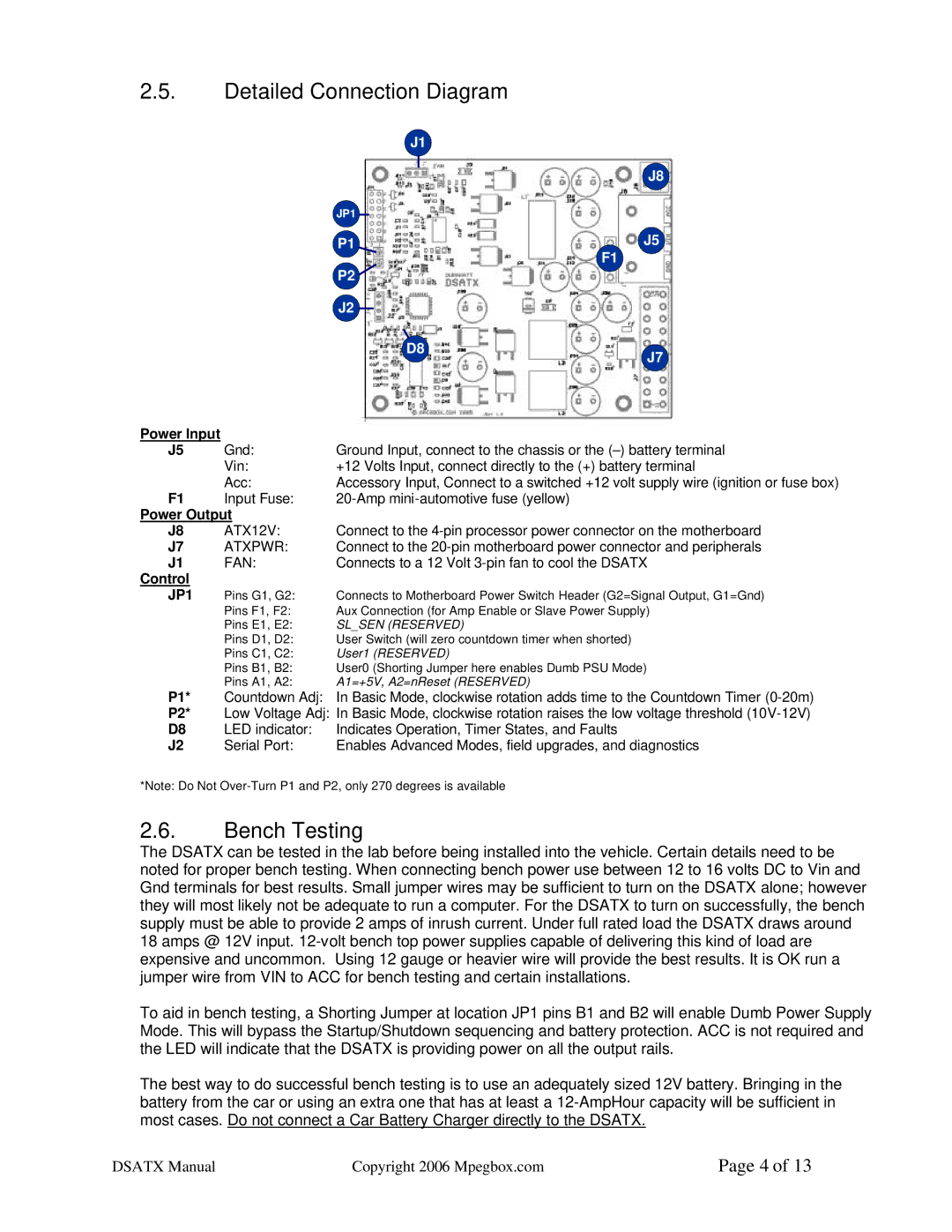
2.5.Detailed Connection Diagram
| J1 |
| J8 |
JP1 |
|
P1 | J5 |
| F1 |
P2 |
|
J2 |
|
D8 | J7 |
|
Power Input |
|
|
J5 | Gnd: | Ground Input, connect to the chassis or the |
| Vin: | +12 Volts Input, connect directly to the (+) battery terminal |
| Acc: | Accessory Input, Connect to a switched +12 volt supply wire (ignition or fuse box) |
F1 | Input Fuse: | |
Power Output |
| |
J8 | ATX12V: | Connect to the |
J7 | ATXPWR: | Connect to the |
J1 | FAN: | Connects to a 12 Volt |
Control |
|
|
JP1 | Pins G1, G2: | Connects to Motherboard Power Switch Header (G2=Signal Output, G1=Gnd) |
| Pins F1, F2: | Aux Connection (for Amp Enable or Slave Power Supply) |
| Pins E1, E2: | SL_SEN (RESERVED) |
| Pins D1, D2: | User Switch (will zero countdown timer when shorted) |
| Pins C1, C2: | User1 (RESERVED) |
| Pins B1, B2: | User0 (Shorting Jumper here enables Dumb PSU Mode) |
| Pins A1, A2: | A1=+5V, A2=nReset (RESERVED) |
P1* | Countdown Adj: | In Basic Mode, clockwise rotation adds time to the Countdown Timer |
P2* | Low Voltage Adj: | In Basic Mode, clockwise rotation raises the low voltage threshold |
D8 | LED indicator: | Indicates Operation, Timer States, and Faults |
J2 | Serial Port: | Enables Advanced Modes, field upgrades, and diagnostics |
*Note: Do Not
2.6.Bench Testing
The DSATX can be tested in the lab before being installed into the vehicle. Certain details need to be noted for proper bench testing. When connecting bench power use between 12 to 16 volts DC to Vin and Gnd terminals for best results. Small jumper wires may be sufficient to turn on the DSATX alone; however they will most likely not be adequate to run a computer. For the DSATX to turn on successfully, the bench supply must be able to provide 2 amps of inrush current. Under full rated load the DSATX draws around 18 amps @ 12V input.
To aid in bench testing, a Shorting Jumper at location JP1 pins B1 and B2 will enable Dumb Power Supply Mode. This will bypass the Startup/Shutdown sequencing and battery protection. ACC is not required and the LED will indicate that the DSATX is providing power on all the output rails.
The best way to do successful bench testing is to use an adequately sized 12V battery. Bringing in the battery from the car or using an extra one that has at least a
DSATX Manual | Copyright 2006 Mpegbox.com | Page 4 of 13 |
